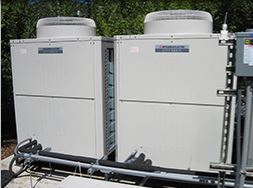
Variable refrigerant flow (VRF) systems represent one of the latest advances in climate control technology for buildings. Replacing traditional air conditioning units, VRF systems split an air conditioner’s systems apart. With multiple evaporators located throughout the building, the amount of cooling being delivered can be customized to increase efficiency and save energy. When combined with heat pump or heat recovery technology, they can generate additional savings.
Traditional air conditioners work by compressing the refrigerant to make it turn into a hot gas. Then, it gradually gives up its heat so that it becomes a cooler liquid. That liquid passes through the evaporator where it absorbs heat from the area surrounding it. Since it takes the heat out of the surrounding air, it ends up creating cool air that then gets blown through ducts by fans. The now-warm refrigerant returns to the compressor where it gets heated further and the cycle continues. These direct expansion systems have one compressor and condenser and one evaporator, and the condenser and evaporator are usually relatively close together.
A variable refrigerant flow system has a key difference. It connects one condenser to multiple evaporators. It works by pumping condensed liquid to smaller evaporators that can be located throughout the system. A computerized control system determines how much refrigerant to send to each evaporator to generate cooling.
The benefits of the variable refrigerant flow system come from its multiple evaporators and its variable nature. Here is how a VRF system saves you money and increases comfort in your building:
- Cool air can be generated closer to where it gets used, reducing the amount of cooling that gets lost during long and potentially leaky runs of ductwork.
- The main system control that drives the condenser and compressor can tailor the amount of refrigerant that it sends, letting it operate at the most efficient level instead of at the all-on or all-off nature of traditional systems.
- Variable refrigerant systems can always be on at a low level, instead of cycling on and off. This leads to more stable indoor temperatures and greater comfort.
- Having multiple evaporators makes it easier for you to split your building into multiple zones, letting you provide more cooling where you need it and less where you don’t. It also potentially allows your workers to control their thermostats so that those who are always warm can cool their areas down while those that need a sweater in summer can warm up.
A variable refrigerant flow system can result in real savings. HVAC experts conservatively estimate that VRF HVAC systems have 10 percent lower operating costs than traditional systems. While they cost more up front, many systems recoup the additional cost in five years or less.
Contact the ARC team and request an assessment to determine if a VRF system could be right for your building. VRF systems have been in use abroad for decades, and their proven technology can work in your building.




